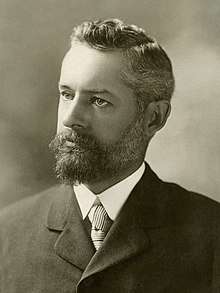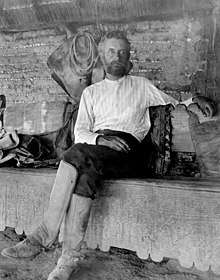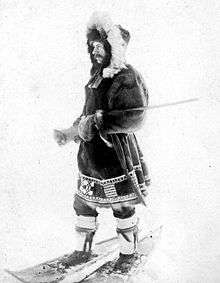Edward William Nelson
Edward William Nelson (May 8, 1855 – May 19, 1934) was an American naturalist and ethnologist. He was born in Manchester, New Hampshire. A collector of specimens and field naturalist of repute, he became a member of several expeditions to survey the fauna and flora. He was part of a team with Clinton Hart Merriam that took part in the Death Valley Expedition. He also explored the Yosemite Valley. A number of vertebrate species are named after him.


Biography
Nelson was born in Amoskeag, New Hampshire on 8 May 1855, the first son of William and Martha (née Wells) Nelson. The family lived in Manchester, New Hampshire. Nelson and his brother then lived with his maternal grandparents in the Adirondacks when his father joined the Union Army and mother went to Baltimore as a nurse. Here he fell in love with the wilderness. Nelson moved to Chicago after his father was killed in the Civil War and his mother established a dressmaking business. In 1871 his large insect collection was lost in the Chicago Fire and the family was left homeless.[1] This was the time that he moved focus from insects to birds. He went to Cook County Normal School from 1872 to 1875 where the principal, W.W. Wentworth encourage him. Nelson also met Henry Henshaw and Edward Drinker Cope who helped him develop his interests in birds.[2] In 1877 Nelson joined the U.S. Army Signal Corps. Spencer Fullerton Baird was responsible for selecting Signal Officers for the remoter stations, and would choose men with scientific training who were prepared to study the local flora and fauna. Baird sent Nelson to St. Michael, Alaska.[2]
Nelson was the naturalist on board the USRC Corwin, which sailed to Wrangel Island in search of the USS Jeanette in 1881. Nelson published his findings in the Report upon Natural History Collections Made in Alaska between the Years 1877–1881 (1887). He also published his ethnological findings in The Eskimo about Bering Strait (1900).

In 1890 Nelson accepted an appointment as a special field agent with the Death Valley Expedition under Clinton Hart Merriam, chief of the Division of Ornithology and Mammalogy, United States Department of Agriculture. After this expedition he was ordered to conduct a field survey in Mexico, and Nelson remained in the country for the next fourteen years. Nelson continued to work for the Bureau of Biological Survey until 1929, being chief of the bureau from 1916 to 1927.[2]
The desert bighorn sheep and Nelson's milksnake were named in his honor. The holotype of the milksnake was collected by Nelson and Edward Alphonso Goldman on July 18, 1897. He worked with Goldman for ten years surveying Mexican terrestrial vertebrates. Nelson's sparrow (Ammodramus nelsoni) (formerly Nelson's sharp-tailed sparrow; formerly sharp-tailed sparrow) was also named for him.[3] Rodents named in his honor include Oryzomys nelsoni, Xenomys nelsoni, Ammospermophilus nelsoni, Heteromys nelsoni, Dicrostonyx nelsoni, Dipodomys nelsoni, Chaetodipus nelsoni, Megadontomys nelsoni, Neotoma nelsoni and Nelsonia.
In addition to the above-mentioned Nelson's milk snake (Lampropeltis triangulum nelsoni ), four other reptiles are named in honor of Nelson: Nelson's anole (Anolis nelsoni ), Nelson's tree lizard (Urosaurus bicarinatus nelsoni ), Nelson's spiny lizard (Sceloporus nelsoni ), and Nelson's spotted box turtle (Terrapene nelsoni ).[4]
He was the president of the American Society of Mammalogists from 1921 to 1923.[5] He also served as president of the American Ornithologists' Union and the Biological Society of Washington. He never married.[2]
See also
| Wikimedia Commons has media related to Edward William Nelson. |
Notes
- Beltz, Ellin (2006), "Biographies of People Honored in the Names of the Reptiles and Amphibians of North America.", Names of the Reptiles and Amphibians of North America – Explained
- Goldman, Edward A. (1935). "Edward William Nelson - Naturalist, 1855-1934" (PDF). Auk. 52 (2): 135–148.
- Bell, Edwin L.; Smith, Hobart M.; Chiszar, David (2003), "An Annotated List of the Species-Group Names Applied to the Lizard Genus Sceloporus." (PDF), Acta Zoologica Mexicana, number 90: 103–174
- Beolens, Bo; Watkins, Michael; Grayson, Michael (2011). The Eponym Dictionary of Reptiles. Baltimore: Johns Hopkins University Press. xiii + 296 pp. ISBN 978-1-4214-0135-5. ("Nelson, E.W.", p. 188).
- Biographies of ASM Presidents, American Society of Mammalogists
- IPNI. E.W.Nelson.
References
Further reading
- Nelson, Edward William The Eskimo About Bering Strait Washington, Government Printing Office, 1900
- Fitzhugh, William W., Susan A. Kaplan, and Henry B. Collins. 1982. Inua: spirit world of the Bering Sea Eskimo. Washington, D.C.: Published for the National Museum of Natural History by the Smithsonian Institution Press. Introductory chapter, part 1 Introductory chapter, part 2
External links
- Smithsonian Anthropologist William W. Fitzhugh speaks about Edward Nelson's 1877-1881 Western Alaskan Expedition (YouTube video)
- William W. Fitzhugh introduction to 1983 reprint edition of Edward William Nelson, The Eskimo About Bering Strait
- Works by or about Edward William Nelson at Internet Archive